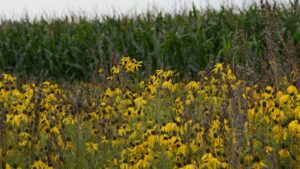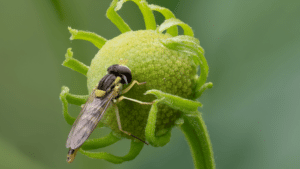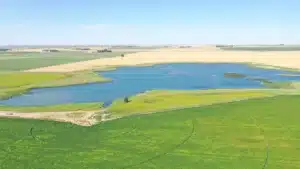It’s never too early to start thinking about pesticide stewardship.
Spring is almost in the air. The spring bloom for some specialty crops is on the horizon and the growing season for corn and soybeans will follow shortly after. It might be early, but it’s never too soon to think about pollinators and pesticide stewardship.
Caydee Savinelli, Syngenta pollinator and integrated pest management stewardship lead says farmers, crop advisors and applicators should think about pollinators and pesticide stewardship now as they prepare for the spring and summer growing seasons.
“We want to keep reminding people as they prepare for planting, and then as the year progresses,” she says. “Farmers are so busy, and now is the time to start taking those steps toward product stewardship.”
The No. 1 piece of advice from anyone in the industry is to simply read and follow the pesticide label or seed tag directions. The next step is communicating with local beekeepers to understand local pollinator visitation habits.
Tag Tells All
Whether a seed tag or a pesticide label, Savinelli says the labels are always the place to start.
“First, if you’re reading a seed tag, it will tell you the active ingredient or ingredients the seeds have been treated with, and it will include any pollinator precautions, stating that a certain active ingredient is highly toxic or toxic to bees, so farmers and applicators know right away they need to be mindful of potential exposure,” she says.
Jim Perrin, aerial applicator and owner of Agricair Flying Service, Inc., says that reading the label might actually give more freedom if the product label doesn’t include that pollinator protection language.
“A lot of the products we spray now are not a concern for pollinators, and reading the tag gives us the information to determine how and when we can spray,” Perrin says.
Savinelli says the labels also include personal protective equipment guidelines and instructions for following local or state disposal guidelines for spilled or leftover seed.
“It’s important to check with local Extension offices for those local guidelines,” she says.
One myth is that farmers or applicators can skip reading the tag if the product is the same as they’ve used before.
Perrin says all products have to go through a recertification process every seven years, so even older products have updated labels with clear pollinator protection language and guidelines for how and when to spray.
Technology Adds Efficiency
As awareness for pollinators and pesticide stewardship grows, so does the technology available to support it.
Savinelli says lubricants and other technological improvements for seed treatments help reduce dust off, in addition to newer equipment designed for reducing dust, while Perrin says all their airplanes are now night vision goggle (NVG) equipped and certified for pollinator protection.
“When it comes to drift reduction, there have been a number of developments to better the application, such as GPS technology, shortening the booms, multiple shut off valves to ensure accuracy,” Perrin says. “Those things help reduce a lot of the drift we used to see.”
“We spent $57,000 per airplane to equip them to be able to fly at night, and a lot of our spray schedule is dictated by the bees’ foraging habits, so this lets us spray some in the morning, then go home to sleep, and get back out and spray most of the night.”
Night vision technology is relatively new to the industry, although Perrin says night spraying has been done for many years using lights. However, with the humidity in the Midwest, the night vision goggles are a must to extend the
spraying hours.
“Like any industry, technology is important as we increase our stewardship efforts and learn more about what we can do to protect pollinators,” he says.
Those technology advances are not limited to just equipment. The chemistry behind new products has also improved in recent years.
“A lot of the newer products we spray are considered safe for pollinators,” he says, adding that he sees more products labeled for use in both organic and conventional products.

Perrin also says that technology has allowed products to be applied more evenly, which means a lot less product is actually used than in years past.
Communication Is Key
One tool that helps with communication is FieldWatch, a non-profit company that provides easily accessible mapping tools to increase communication and awareness between producers of specialty crops, beekeepers and pesticide applicators.
Perrin certainly values that option, but says it has limits, too.
“Not all the commercial beekeepers use that tool, because they are protective of where they keep their hives, so it’s not the only thing to check,” he says.
In addition to programs such as FieldWatch, Perrin says he’s seen a lot of progress in how different groups communicate. He believes it’s a simple, neighborly thing to do, even without a growing concern for pollinator stewardship.
“Just go introduce yourself to your neighbors. If you see hives, find out who manages them and be sure to communicate that information to any custom applicators you work with,” he says.
“Years ago, I did see a lot of different groups butting heads, but now, for the most part, everyone is trying to work together.
“We have daily communication with beekeepers near where we’re working, and more conversations with farmers. Honestly, a lot of these issues can be worked through with some simple communication, and it’s good to see that happening more and more.”
Best Practices
Following best practices during application to minimize spray drift is also an important step toward stewardship.
On the applicator side, that means continuing to spray during the bees’ off times, even at night, and ensuring equipment is always working properly.
“Some things need to be sprayed at night or when it’s below 55 degrees, because that’s when the pollinators are least likely to be out,” Perrin says. “And we are constantly monitoring the spray nozzles to ensure the flow per minute is where it should be. If there is a problem, we can address it immediately.”
He also says mentoring is important for new applicators to ensure they develop the skills and stewardship awareness necessary.
Savinelli says establishing a buffer where necessary to prevent aerial drift can be helpful, as well as always checking
for weather and wind patterns during planting or times of pesticide application.
Steps for Success
Starting the year with stewardship sets the tone for a successful, safer year for everyone.
“There are a lot of resources and programs for information as the year progresses,” Savinelli says.
The dust is the main concern with treated seed, and a great deal of work has been done to mitigate that as research and technology improve.
“We know a lot more than we did several years ago, and we can give better recommendations based on our scientific research,” Savinelli says.
That’s another reason to keep reading those seed tags and product labels, even if you read them last year, and the year before, and the year before.
“Science is always evolving and we’re continuing to make products safer and better. That’s the important thing,” Savinelli says.
Perrin adds: “It’s worth it for the bees. We all need to do what we can.”













